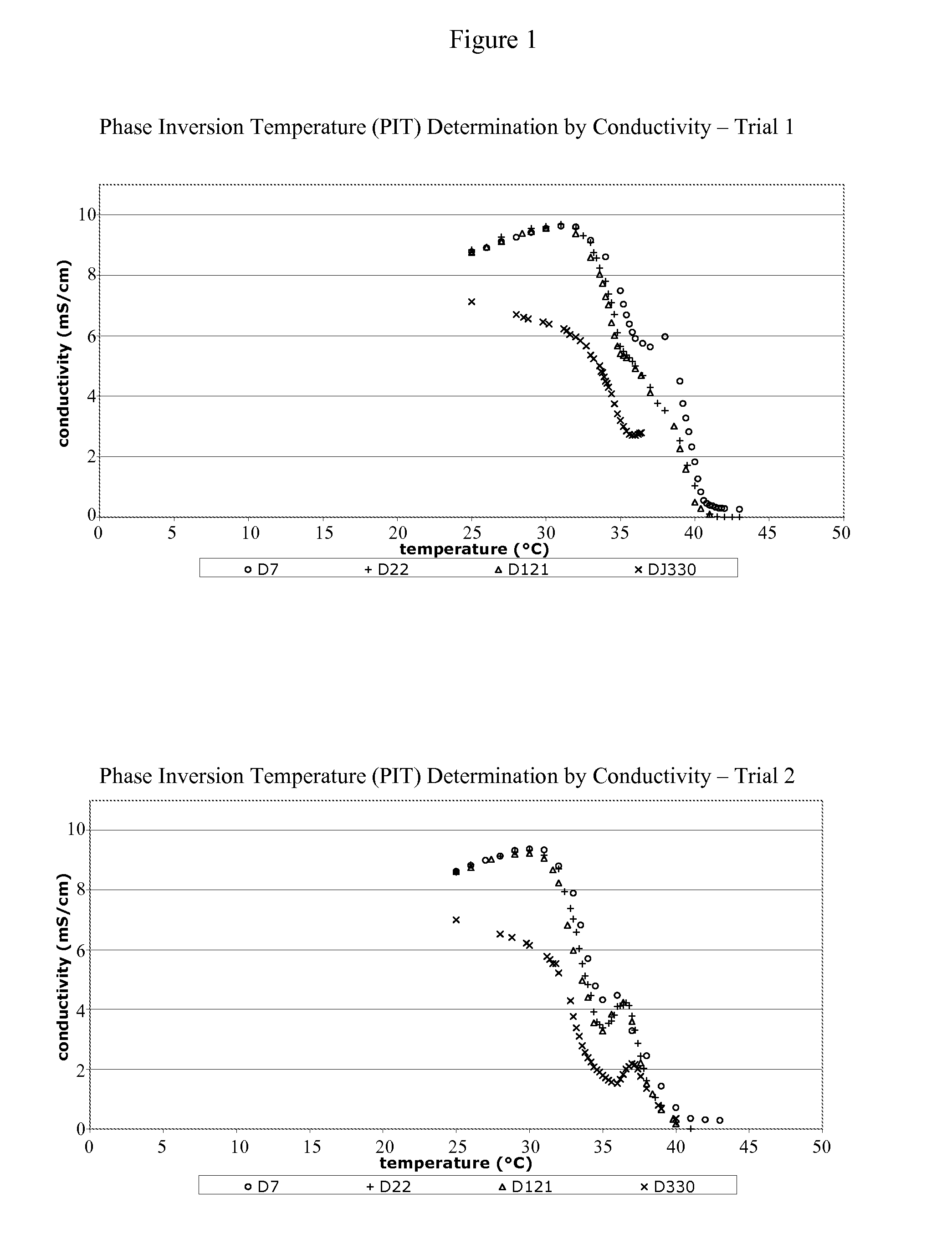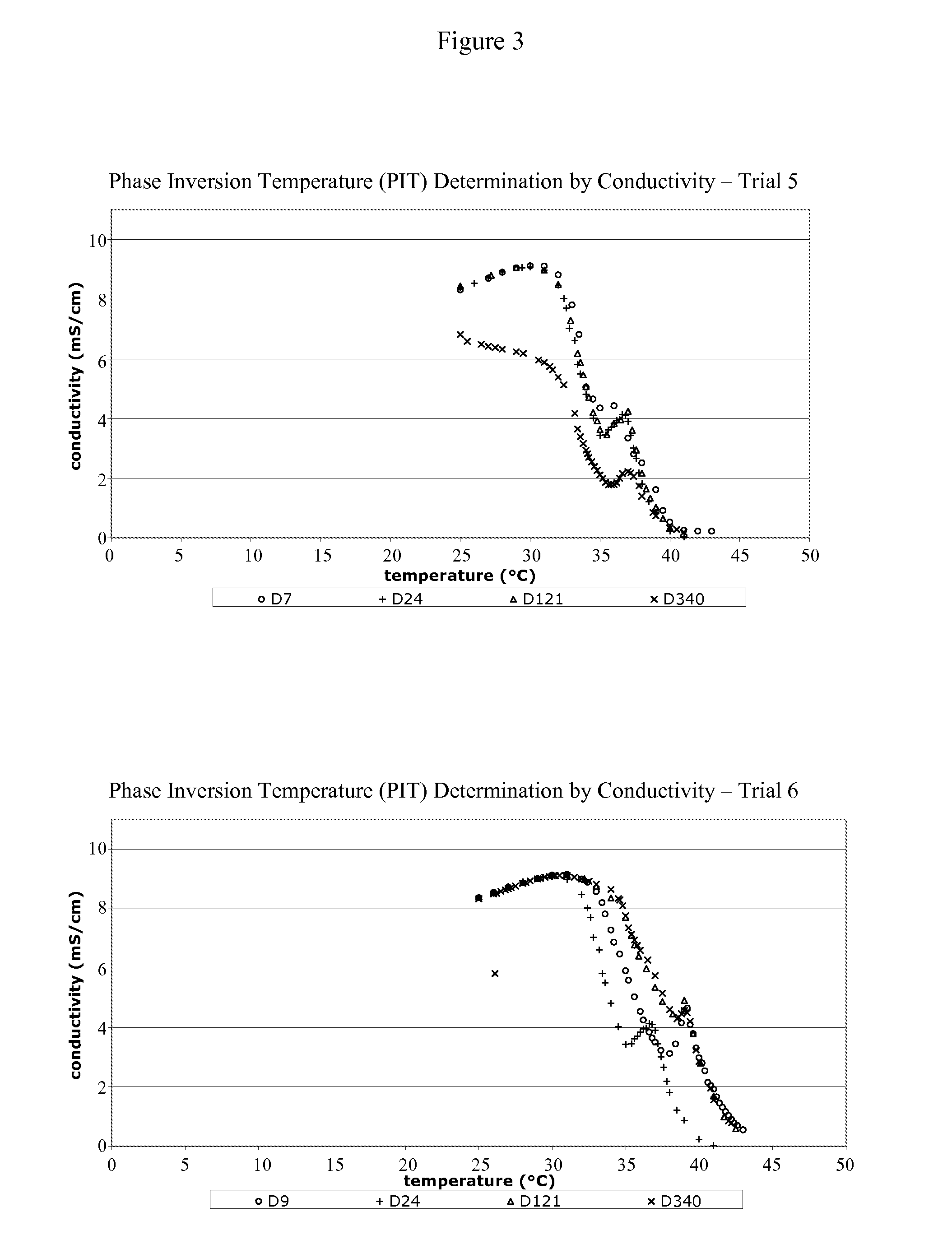Vaccine Formulations Comprising Saponin-containing Adjuvants
- Summary
- Abstract
- Description
- Claims
- Application Information
AI Technical Summary
Benefits of technology
Problems solved by technology
Method used
Image
Examples
example 1
Emulsion Manufacturing Method
[0167]The emulsion was prepared by Inversion method. In a first step, the aqueous phase and the oily phase were mixed together at +40° C. In a second step, the emulsion was cooled progressively below the PIT at +5° C. in order to obtain an O / W emulsion. After inversion, the final emulsion (i.e. vaccine formulation) was mixed and subsequently stored at +5° C. (summarized in Table 1).
TABLE 1Percent forPercentEach PhaseTotal (v / v)Incomplete Emulsion - Oily phase (120 mL):33Sorbitan monooleate (SPAN 80 ®) 1.8% w / vSorbitan trioleate (20 OE) (TWEEN 85 ®) 10.2% w / vParaffin oil (MARCOL 82 ®) 88% v / vIncomplete Emulsion - Aqueous phase #133(120 mL):20% (w / v) solution of sorbitan monooleate11.25% w / v(20 OE) (TWEEN 80 ®)Phosphate disodic and monopotassic 0.02M85.75% v / visotonic buffer (pH 7.8)Incomplete Emulsion = Oily + Aqueous #166Ratio Incomplete Emulsion / Final Emulsion (i.e.⅔Vaccine Formulation)Add Aqueous phase #2 (120 mL):33[Phosphate disodic and monopotassic...
example 2
Determination of the Phase Inversion Temperature (PIT) of an Emulsion
[0175]10 ml of the TSAP emulsion was placed into a glass tube in a water-bath at a temperature of about 25° C. The TSAP emulsion was a white homogeneous emulsion. The temperature in the water bath was progressively increased. Changes in the emulsion were visually observed (the emulsion became two separated phases due to the migration of the yellow-brown oily phase to the surface). This change is characteristic of the breakdown of the emulsion. The temperature at which this change is observed is the PIT value of the emulsion. For the TSAP emulsion, the PIT ranges from about 36° C.-46° C. FIGS. 1-5 provide PIT determination graphs for vaccine formulations made according to the present invention (1 year stability study). FIG. 6 provides a PIT determination graph for vaccine formulations made according to the present invention and stored for 36 months (3 year stability study).
example 3
Study #1: Stability of Vaccine Formulations Prepared According to Example 1
[0176]This table indicates the stability (i.e. the time in months the formulations remain as oil in water emulsions) of vaccine formulations prepared according to the method described in Example 1. The formulations are comprised of the indicated constituent ingredients (see formulations 1-13), and the antigens used for each of these formulations comprised inactivated FMD virus isolates that were considered moderately to highly purified.
[0177]As Table 2 indicates, the presence of Aluminum hydroxide provides increased vaccine stability especially when the highest concentration of antigen is used (compare the enhanced stability of formulations 9, 11, and 13 to the relatively reduced stability at 12 months of formulations 3, 5, and 7). On average, the presence of Aluminum hydroxide in the higher antigen-containing formulations (i.e. formulations 9, 11, and 13) increases the oil / water stability time from about 3-6...
PUM
| Property | Measurement | Unit |
|---|---|---|
| Temperature | aaaaa | aaaaa |
| Temperature | aaaaa | aaaaa |
| Fraction | aaaaa | aaaaa |
Abstract
Description
Claims
Application Information
 Login to View More
Login to View More - R&D
- Intellectual Property
- Life Sciences
- Materials
- Tech Scout
- Unparalleled Data Quality
- Higher Quality Content
- 60% Fewer Hallucinations
Browse by: Latest US Patents, China's latest patents, Technical Efficacy Thesaurus, Application Domain, Technology Topic, Popular Technical Reports.
© 2025 PatSnap. All rights reserved.Legal|Privacy policy|Modern Slavery Act Transparency Statement|Sitemap|About US| Contact US: help@patsnap.com



